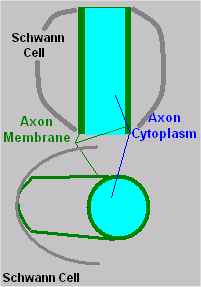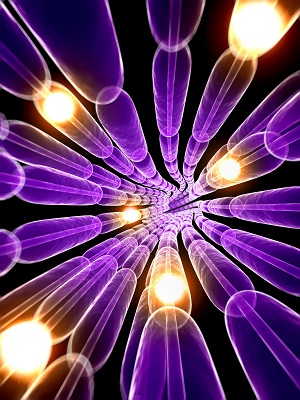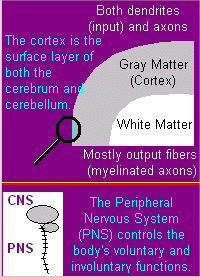25 Dec Myelin Sheath Function: Insulators

Glial Cells
Gray matter / white matter… what really matters? Glial cells form a white myelin sheath around axons and function as the nervous system‘s supporting actors. They are more numerous than neurons – there are over 100 billion neuroglia, many wrapped around the efferent (output) fibers of each nerve cell. They support impulse conduction by forming sheaths which act as insulators around axon membranes. The sheaths are formed by a type of glia called oligodendrocytes in the brain and Schwann cells in the peripheral nervous system. Oligodendrocytes are normally round when they first form, but the process of myelination causes them to change shape. This is caused by Schwann cells wrapping their lipoprotein plasma membrane processes 1-20 times around an axon. They form segmented lengths along axons called nodes of Ranvier.
The illustrations above show Schwann cells wrapped entirely around a nerve axon. Because of the amount of electrical current and chemical activity in the brain, insulators are necessary to direct the flow of action potentials and protect adjacent fibers and membranes from accidental exposure.
| Understanding Context Cross-Reference |
|---|
| Click on these Links to other posts and glossary/bibliography references |
|
|
|
| Prior Post | Next Post |
| Neuron Components and Cybernetics | Cytoskeleton Components in Cognition |
| Definitions | References |
| Schwann cells neuroglia | Manatomy on Neuroglia |
| Oligodendrocytes myelin | Kuffler 1984 |
Astrocytes
The insulating properties of glial cells extend beyond the insulation of single cells. The white matter, which consists primarily of glial cells, also insulates the whole cortex or gray matter area from other areas of the brain. Although the layers in the cerebrum and cerebellum described earlier are not wholly insulated from one another, different parts of the brain are separated by this material that effectively limits the flow of electrical potential. Consequently, if we describe the brain using the “neural network” analogy, it is reasonable to speak of multiple separate but tightly interconnected networks.
In addition to oligodendrocytes and Schwann cells, there is another type of neuroglia called astrocytes. All glia form a single type of process (branch) that enables them to reach out to extend their influence beyond the nuclear area. Some astrocyte glia have processes extending to the surface of the central nervous system, where they form a glial limiting membrane. Glial cells also assist in the maintenance of proper fluid levels throughout the brain and limit the access of blood to only required areas of the cranium.
 Glial cells also have cytoskeletal filaments, which are described in the cytoskeleton posts to come soon. Their functions may include giving structure to the polymorphous cells and contributing to the growth process. In addition, glia have many of the organelles and chemicals that are present in other nerve cells, so they may someday play a role in cybernetics.
Glial cells also have cytoskeletal filaments, which are described in the cytoskeleton posts to come soon. Their functions may include giving structure to the polymorphous cells and contributing to the growth process. In addition, glia have many of the organelles and chemicals that are present in other nerve cells, so they may someday play a role in cybernetics.
Functions of Glial cells (from Mananatomy.com)
- Provide structural or mechanical support to neurons’ fibers.
- Act as insulators between the neurons and prevent neuronal impulses from spreading in unwanted directions.
- Help to remove the foreign material and cell debris by phagocytosis.
- Help repair the damaged areas of nervous tissue by proliferation (gliosis) they form glial scar tissue, and fill the gaps left by degenerated neurons.
- Take up and store neurotransmitters released by the neighboring synapses. These can-either be metabolized or released again from the glial cells.
- Help regulate neuronal functions by maintaining a suitable metabolic and ionic environment for the neurons.
- Oligodendrocytes myelinate tracts.
- Ependymal cells are concerned with exchanges of materials between brain and Cerebrospinal Fluid.
Pathologies
 Multiple sclerosis affects myelin, the white substance that constitutes glia. The disease is like the opposite of acquired immune deficiency syndrome: rather than disabling the immune system, MS makes it hyperactive. The hyperactive immune system attacks myelin, causing it to lose its flexibility and leave hardened regions of white matter in the central layers of the brain. As we will see in Volume 3, inter-cellular communication relies to a great extent on the performance of myelin as a flexible insulator.
Multiple sclerosis affects myelin, the white substance that constitutes glia. The disease is like the opposite of acquired immune deficiency syndrome: rather than disabling the immune system, MS makes it hyperactive. The hyperactive immune system attacks myelin, causing it to lose its flexibility and leave hardened regions of white matter in the central layers of the brain. As we will see in Volume 3, inter-cellular communication relies to a great extent on the performance of myelin as a flexible insulator.
MS affects the motor control system more frequently (and often, more profoundly) than the remembering and reasoning components of the brain. The impact of this disease ranges from mild cases (more common) where the only detectable results are tiredness and numbness in the extremities to physical disability that forces people into wheelchairs, causes loss of memory, and occasionally even results in dementia. We will revisit the effects of multiple sclerosis when we consider intercellular communication models and the characteristics of devices that would strengthen or disable systems that imitate the brain.
Contribution to Cognition
Since many parts of the body participate in cognition, it is possible that we will someday learn that glial cells play a significant role in the complex processes of thought. Though the participation of myelin in the human cognitive apparatus may seem to be peripheral or even immaterial to attempts to design artificial models, the results of MS are central to understanding the real thing. We cannot ignore this (and other pathologies such as agnosia and aphasia) if we want to design a robust model of the brain. I propose we use the principle of insulation as a guiding principle in the design.
Guiding Principle: While allowing some unexpected cross-talk between concepts when simulating resonances in the brain, insulate, as much as possible, unrelated knowledge or concepts from interfering with accurate interpretation of the concepts and contexts of the immediate input.
| Click below to look in each Understanding Context section |
|---|









